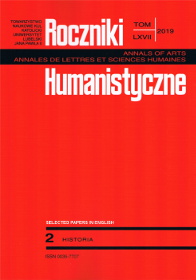The Image of the United States of America in the Polish Newsreels (PKF) 1948–1953
Abstract
The Polish version of the article was published in Roczniki Humanistyczne 59 (2011), issue 2.
This article analyzes the contents of sections of Polish Newsreel (PKF) of the years 1948–1953 concerning the United States of America in the context of political, international, military, economic and social issues. The image of the USA shown in Polish Newsreel did not have a lot in common with reality and it was part of the vision of the world created for propaganda needs. The propaganda machine, a part of which Polish Newsreel was, in order to achieve the aims that it had set out, used a whole palette of propaganda techniques and rules: selecting the prepared footage, generalizations, the use of characteristic clusters of ideas (“warmongers”, “American perpetrators of genocide”, “the new SS”, “the bondage of the dollar”), combining information with interpretation. All of this was done with the use of the modern medium, that is, film. Joining the layers of pictures, sound and commentary, as well as the particular conditions encountered during screenings of Polish Newsreel shows gave the viewer the possibility to deeply experience the scenes presented, to get emotionally involved in them, and, hence, to identify with the imposed interpretation of the viewed material.
References
Budoran, K. Propagandowy obraz polityki zagranicznej PRL w świetle polskiej Kroniki Filmowej z lat 1944–1956 [The Propaganda Image of the Polish People’s Republic’s Foreign Policy in the Light of the Polish Newsreel of 1944–1956] (typescript in the Author’s collection).
Cieśliński, Marek. Piękniej niż w życiu. Polska Kronika Filmowa 1944–1994 [More Beautiful Than Life: Polish Newsreel 1944–1994]. Warszawa: Trio, 2006.
Cieśliński, Marek. “Polska Kronika Filmowa 1945–1955. W kleszczach urzędniczych decyzji [Polish Newsreel 1945–1955: In the Grip of the Clerks’ Decisions].” In Realizm socjalistyczny w Polsce z perspektywy 50 lat [Socialist Realism in Poland from the Perspective of 50 Years], edited by Stefan Zabierowski, 244–257. Katowice: Wydawnictwo UŚ, 2001.
Dobek-Ostrowska, Bogusława. “Propaganda jako forma komunikowania [Propaganda as a Form of Communication].” In Beata Ociepka, Janina Fras, and Bogusława Dobek-Ostrowska. Teoria i praktyka propagandy [The Theory and Practice of Propaganda], 7–28. Wrocław: Wydawnictwo Uniwersytetu Wrocławskiego, 1999.
Fras, Janina. “Język propagandy politycznej [The Language of Political Propaganda].” In Beata Ociepka, Janina Fras, and Bogusława Dobek-Ostrowska. Teoria i praktyka propagandy [The Theory and Practice of Propaganda], 84–110. Wrocław: Wydawnictwo Uniwersytetu Wrocławskiego, 1999.
Hendrykowski, Marek. Film jako źródło historyczne [The Film As a Historical Source]. Poznań: Ars Nova, 2000.
Hirszowicz, Maria. Pułapki zaangażowania. Intelektualiści w służbie komunizmu [The Traps of Involvement: Intellectuals in the Service of Communism]. Warszawa: Scholar, 2001.
Karczowa, Helena. “Reportaż filmowy i kronika jako źródło historyczne [The Film Documentary and the Newsreel as a Historical Source].” Studia Źródłoznawcze 16 (1971): 25–31.
Lemann-Zajiček, Jolanta. Kino i polityka. Polski film dokumentalny 1945–1949 [The Cinema and Politics: Polish Documentary Films 1945–1949]. Łódź: PWSFTviT, 2003.
Madej, Alina. Kino. Władza. Publiczność. Kinematografia polska w latach 1944–1949 [The Cinema. The Authorities. The Audience: Polish Cinematography in the Years 1944–1949]. Bielsko-Biała: Prasa Beskidzka, 2002.
Malendowski, Włodzimierz. “Zimna wojna. Rywalizacja radziecko-amerykańska w systemie bipolarnym. Problemy periodyzacji i rekonstrukcji najważniejszych zdarzeń [The Cold War. The Soviet-American Rivalry in a Bi-polar System: The Problems of the Periodization and Reconstruction of the Most Important Events]. In Zimna wojna (1946–1989) i jej konsekwencje dla ładu międzynarodowego [The Cold War (1946–1989) and Its Consequences For the International Order], edited by Bogdan Koszel and Sebastian Wojciechowski, 9–35. Poznań: Instytut Zachodni. Wyższa Szkoła Nauk Humanistycznych i Dziennikarstwa 2007.
Malendowski, Włodzimierz. Zimna wojna. Sprzeczności, konflikty i punkty kulminacyjne w radziecko-amerykańskiej rywalizacji [The Cold War. The Contradictions: Conflicts and Culminating Points in the Soviet-American Rivalry]. Poznań: Wydawnictwo Naukowe Instytutu Nauk Politycznych i Dziennikarstwa UAM, 1994.
Murawska-Muthesius, Katarzyn. “Jak rysować podżegaczy wojennych? Obraz Zachodu w socrealistycznej karykaturze radzieckiej i polskiej 1946–1954 [How to Draw the Warmongers? The Picture of the West in the Socialist Realist Soviet and Polish Caricature 1946–1954].” In Realizm socjalistyczny w Polsce z perspektywy 50 lat [Socialist Realism in Poland from the Perspective of 50 Years], edited by Stefan Zabierowski, 258–272. Katowice: Wydawnictwo UŚ 2001.
Nowak, Paweł. Swoi i obcy w językowym obrazie świata. Język publicystyki polskiej z pierwszej połowy lat pięćdziesiątych [Friends and Foes in the Language Picture of the World: The Language of Polish Journalism in the First Half of the Fifties]. Lublin: Wydawnictwo UMCS, 2002.
Ociepka, Beata. “Propaganda w Trzeciej Rzeszy [Propaganda in the Third Reich].” In Beata Ociepka, Janina Fras, and Bogusława Dobek-Ostrowska. Teoria i praktyka propagandy [The Theory and Practice of Propaganda], 113–130. Wrocław: Wydawnictwo Uniwersytetu Wrocławskiego, 1999.
Rabiński, Jarosław. “Władza nowoczesna? Rola mediów w państwie totalitarnym [Modern Authority? The Role of the Media in a Totalitarian State].” In (Kon)teksty kultury medialnej. Analizy i interpretacje [The (Con)Texts of Media Culture. Analyses and Interpretations], edited by Marek Sokołowski. Vol. 2, 7–15, Olsztyn: Algraf 2007.
Szczurowski, Maci9ej. “Dokument filmowy i telewizyjny. Określenie problematyki badawczej, [Film and TV Documentaries: Defining the Research Issues].” In Dokument filmowy i telewizyjny [Film and TV Documentaries], edited by Maciej Szczurowski, 21–37. Toruń: Wydawnictwo Adam Marszałek 2004.
Topitsch, Ernst. Wojna Stalina. Długofalowa strategia radziecka wobec Zachodu jako racjonalna polityka siły [Stalins Krieg: Moskaus Griff nach der Weltherrschaft]. Translated by Darisuz Aleksandrowicz. Wrocław: Ossolineum, 1996.
Urbaniak, Janusz. “O sposobie realizowania ‘Polskiej Kroniki Filmowej’ w latach czterdziestych [On the Way ‘Polish Newsreel’ Was Edited in the Nineteen-Forties].” In Estetyka i struktura dzieła filmowego [The Esthetics and Structure of the Film], edited by Jan Trzynadlowski, 203–213. Wrocław: Wydawnictwo Uniwersytetu Wrocławskiego, 1987.
Urbaniak, Janusz. “ ‘Polska Kronika Filmowa,’ ‘zimna wojna’ i świat. O zmienności ekranowego obrazu [‘Polish Newsreel,’ the Cold War and the World: On the Changeability of the Screen Picture],” In Film: obraz – język – wyobraźnia – idea [Film: Picture – Language – Imagination – Idea], edited by Jan Trzynadlowski, 213–231. Wrocław: Wydawnictwo Uniwersytetu Wrocławskiego, 1994.
Copyright (c) 2019 Roczniki Humanistyczne

This work is licensed under a Creative Commons Attribution-NonCommercial-NoDerivatives 4.0 International License.





